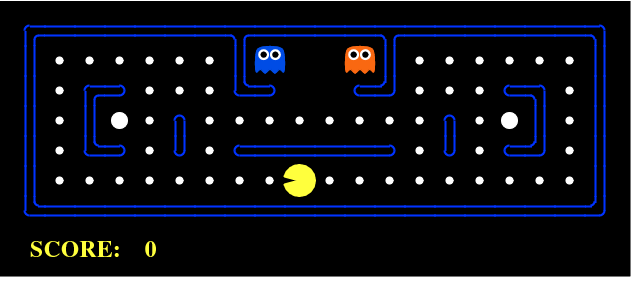The Pac-Man Projects

Overview
The Pac-Man projects were developed for CS 188. They apply an array of AI techniques to playing Pac-Man. However, these projects don’t focus on building AI for video games. Instead, they teach foundational AI concepts, such as informed state-space search, probabilistic inference, and reinforcement learning. These concepts underly real-world application areas such as natural language processing, computer vision, and robotics.
We designed these projects with three goals in mind. The projects allow you to visualize the results of the techniques you implement. They also contain code examples and clear directions, but do not force you to wade through undue amounts of scaffolding. Finally, Pac-Man provides a challenging problem environment that demands creative solutions; real-world AI problems are challenging, and Pac-Man is too.
Projects Overview
Project 0: Python, Setup, & Autograder Tutorial
This short tutorial introduces students to conda environments, setup examples, the Python programming language, and the autograder system.
Project 1: Search
Students implement depth-first, breadth-first, uniform cost, and A* search algorithms. These algorithms are used to solve navigation and traveling salesman problems in the Pacman world.
Project 2: Multiagent Search
Classic Pacman is modeled as both an adversarial and a stochastic search problem. Students implement multiagent minimax and expectimax algorithms, as well as designing evaluation functions.
Project 3: Reinforcement Learning
Students implement Value Function, Q learning, and Approximate Q learning to help pacman and crawler agents learn rational policies.
Project 4: Bayes Nets and HMMs
Pacman uses probabilistic inference on Bayes Nets and the forward algorithm and particle sampling in a Hidden Markov Model to find ghosts given noisy readings of distances to them.
Project 5: Machine Learning
Students implement the perceptron algorithm, neural network, and recurrent nn models, and apply the models to several tasks including digit classification and language identification.
Technical Notes
The Pac-Man projects are written in pure Python 3.6 and do not depend on any packages external to a standard Python distribution.
Support
This project was supported by the National Science foundation under CAREER grant 0643742. Any opinions, findings and conclusions or recommendations expressed in this material are those of the author(s) and do not necessarily reflect the views of the National Science Foundation (NSF).
Credits
The projects were developed by John DeNero, Dan Klein, Pieter Abbeel, and many others.